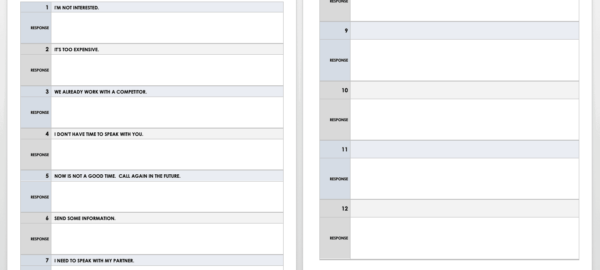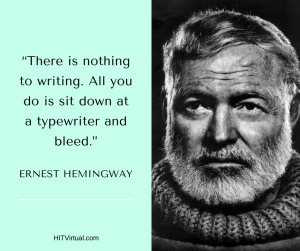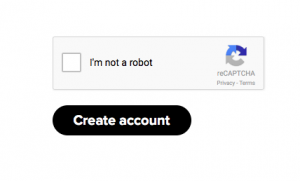Today’s sales process involves a sensible mix of both inbound and outbound prospecting and let’s admit that cold calling and emails still remain the lifeline of outbound prospecting technique.
The hardest part of prospecting is not to get more leads, schedule a meeting or close more deals but to handle objections. Salespeople are repeatedly trained and coached on how to handle several aspects of sales during their sales enablement programs. However, one crucial element that they find particularly difficult, is to deal with ‘objections’.
What are sales objections?
Objections in sales parlance can be the one-liners hurled at the salesperson giving out a clear message to steer clear from the prospect.
No matter when they surface in the sales cycle, either at the start of the sales expedition – during prospecting, where it is not uncommon to hear the “I am too busy right now”, “I am not interested” or during the negotiation phase; they help a salesperson build meaningful conversion by picking up the trail that a disinterested lead leaves behind. They can be an opportunity to clarify, alleviate apprehension, and provide a chance to reassure the prospect about the product/service being offered.
The reason objections are seen with such good faith is because they can help a salesperson uncover the following :
1.How engaged a prospect is with the product or service-
By responding to the salesperson with an objection the prospect has lowered his guard on discussing his difficulty, which is a good sign. Rather than taking his objection at the face value, sales reps should know there is a pain point that can be factored into during the conversation.
2. If there is a scope to further engage with the prospect –
While there are objections which are simply brush offs, several others are pinned on a genuine challenge faced by the prospect. One has to be aware of that and see if there is a scope to extend the conversation around that challenge thereby attempting to provide a solution that otherwise the prospect might not have expected from the salesperson.
3. If there is a potential to qualify them –
Like we all know, “I don’t have time to talk to you” or hanging up at the start of the conversation signals that they are not the leads one should be wasting their time on. Focusing on prospects who fall under the Ideal Customer Framework Profile are the ones who are ready, willing, and able.
4. If there is a way to add value –
Sales always depend on adding value to one’s prospect. If the prospect is hurling objections like “you are too pricey” or “I don’t think I am better off with your competitor”, then its time to perhaps hit the home run with a value proposition that can help clarify the misconception about the product/service to the prospect.
Source: Tibor Shanto on www.sellbetter.ca
“TREAT OBJECTIONS AS REQUEST FOR FURTHER INFORMATION”
-BRIAN TRACY
How do objections manifest?
There are six broad categories under which most of the objections can be grouped under and what should your answer focus on:
An objection of Price – Usually this objection hovers around the factor of price and takes the form of “It’s too expensive”, “product Y is cheaper than yours” or “I need to allocate the budget elsewhere”.
Focus on: This can be flipped to your advantage by conversing about the value the product can deliver.
An objection of Need – There is no requirement. Probably they have got it covered with some other competitor or they are just not there to use your product or they are better off without anything. “Not required”, “My software works just fine”
Focus on: You will need a nudge and bring in the philosophy of FOMO (Fear Of Missing Out).
An objection of Time – They are busy. It’s a crazy time of the year or the prospect is swamped. It’s not unusual to get “Call me next month/quarter”, “Just send me more information” or they are simply not interested right now.
Focus on: Follow up question on what is the best time to reach out to them or use the concept of reframing.
An objection of Authority – When a prospect spells out “I am not authorized to approve this”, they slow down the sales process. The gatekeepers are doing the talking or perhaps that person truly lacks authority to sign off.
Focus on: Key is to ask for decision-makers and take it from there.
An objection of Trust – When sales reps get “how functional is that feature?”, “I haven’t heard about you guys before”, “how good is the customer support”? Salespeople should realize they are facing paranoid targets. They don’t have enough trust in the product because the company is fairly new, they read bad reviews or simply because they aren’t sure about the features of the product.
Focus on: Good time to drive home the USP’S of the product/service. Including customer testimonials.
Disinterest – These are the brush offs that have no hidden meaning other than “I don’t want to buy, no matter what”. Prospects like these are usually people who wouldn’t pen a check and sales reps should know they are fighting a losing battle.
Focus on: They are the ones who got to be disqualified.
How to handle objections?
Handling objection is a calculated and strategic approach that requires practice. When this approach is executed it not only brings back much-valued business to the table but also helps in the process of giving back to the prospect by making his requirement the nucleus of the conversation.
The art of objection handling involves the following:
1. Research: Do the homework. Not only about the prospect but about yourself. Learn the tools and processes. You don’t want to go wrong in presenting an incorrect solution to the prospect let alone staring at your screen when asked how something functions. You can use research about businesses from sites like G2, Crunchbase and Linkedin. Become an expert before you jump into that sales call.
2. Listen: This is one of the quintessential skills of communication. Research at Gong.io shows that top closers listened 67% of the time as against the bottom ones who listened only 34% of the time.

By investing a significant amount of time in building the art of listening, sales reps not only hone the skill of becoming empathetic towards their prospects but also be able to understand the pain points of them.
3. Be Prepared: It is always a good idea to anticipate the objections that you might face even before you dial in. Making a list of possible objections based on the profile and industry of the prospect will come handy when confronting the actual objection. Furthermore, the thought of being armed for the battle is going to ensure you remain calm and collected while dealing with the objections.
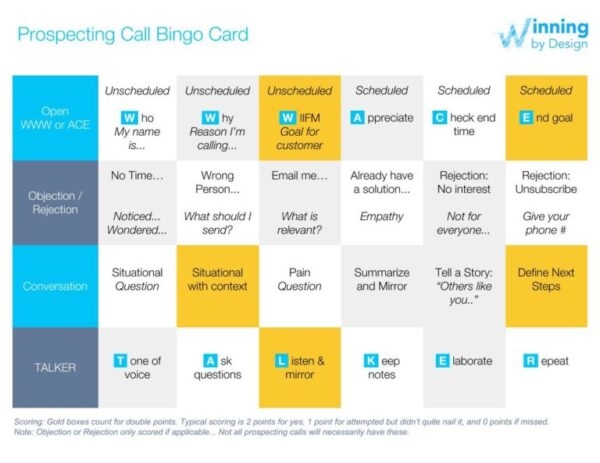
Think about this, Zenfits – A SaaS company launched its sales academy with a fresh approach to sales enablement training by having daily roleplay and a safe zone for teams to practice. They have devised an extremely handy prospecting all bingo card which acts like a blueprint for a good prospecting call. If you feel up to it, you can devise your own blueprint for a prospecting call which helps you keep a tab on what you are going to be talking about and also the objections that you might come across.
4.Understand:
Once the objection is heard, it usually sets off a knee-jerk reaction in letting loose and charging in defense for the product/service. The last thing the prospect wants is to be charged at for what has been spoken. A simple technique to let your target know that you are understanding is by acknowledging what they have just told you and follow up by asking for more clarification or complete the sentence mentioning the emotion you identified with the prospect.
“You are right. I would feel the same if I were facing the same challenge. But have you tried XYZ features in the product?”
“I hear you. It can be frustrating to not have xxxxx”
5. Repeat: Prospects don’t expect you to quiz them about what they have told you. So instead of posing a ‘Why’? to them, you simply modulate your tone and repeat what they have told you to get them to speak more about it. A technique used by Chris Voss of Never Split the Difference is called “Mirroring”. This instigates them to speak up.
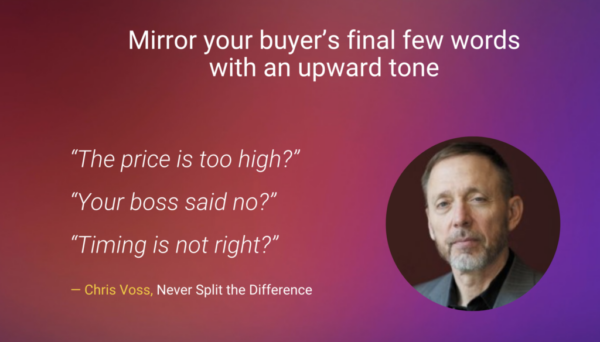
Source: https://www.gong.io/blog/objection-handling-techniques/
6. Reframe: This is a practice of encouraging a whining target into looking at the glass ‘half full’. Rewiring what they just uttered to you as a problem into something that isn’t actually an issue.
For example, if you have a prospect who has expressed concern about now not being the right time to sign up for your service because they are pretty busy, you could reframe their attitude by emphasizing that in another two months time they might have more inflow of business and this service is going help them capitalize on that new business. This way they will focus on the impending profit than on the little amount of time/money spent on putting things in order.
7. Respond: Once you have the information that you need it is fairly simple to string your response together to fit the objection.
Here are few common objections for which Morgan J Ingram, from Jbarrows sales training, explains how to deal with :
“We already work with another vendor.” How do you overcome this?
M.J. says: Don’t start talking about how great your product is, or by listing your product can do X, Y, Z. Instead, slow down, listen to them. Acknowledge by saying – that’s pretty cool you are using this product. What do you like about them?. Here you are pushing them to talk more. Once the prospect lists down things they love about that product ask them, what do they think can be improved? Not what they don’t like. Here you are getting them to fill the gap. Make notes.
Now you say “So, I have made notes of what you would like to improve; I know this may not be an exact fit for you right now, however, I would like to schedule a call with you (suggest time/date), so that you can know what our solution is all about and you could get familiar with our brand. When the time arises, maybe you can transition. Does that sound fair?”
Devin Reed, Content Strategy Manager at Gong.io during his interaction at Jbarrows Sales Training had some revelation about an equally daunting objection “I need to think about it.”
He says when analyzed, this objection does NOT negatively impact win rates. In fact, in deals where it was used, especially during the later stages of the sales cycle, resulting in a 46% win rate in closing the deal.
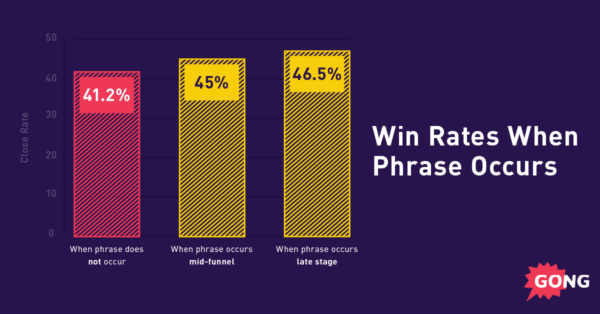
However, beware of this phrase. This when used means there is a proverbial speed bump ahead and most likely will extend your sales cycle by 173%.
But, how do you address the objection when you face one?
Say “When most people tell me they need to think about it, it’s typically because they’re not interested or I missed something in our meeting”
If you missed something, they’ll respond with “No, we’re interested, it’s just that…” That ‘dot dot dot’ is where they start to reveal their uncertainty”. Make use of that.
3 Tools to handle objections
Let’s look at three tools that can help handle objections with a focus on making the prospect’s perspective a focal point without breaking a sweat!
The biggest challenge sales reps face while handling objections is their inability to control what they speak. They are either drawn too much into the conversation or fail to connect with the prospect. This leads them to talk too much or too less.
#1 Videos :
This powerful tool is making waves across the outbound sales industry in bringing together the once lost personalization factor.
Objection surface during sales because the prospect is not convinced about the credibility of the face behind the cold call/email. Videos lift this apprehension by eliminating the surprise arising out of anonymity – a major threat in closing a sale.
When we talk about objections, we must not forget to address the ubiquitous, diplomatic objection “send me more information”. While it may seem like a rather inadvertent, genuine request from your prospect, jumping into sending out an email with information as an attachment will never see the light of the day in the prospect’s inbox.
However when you nudge the prospect further in requesting specific information, such as “I will certainly send you the details you requested. But I would like to know which product you might be more interested to know about X or Y? What add-ons will be your priority A or B?”
Once you get the information, sending out a personalized video email explaining the features of the product they requested will not only go a long way establishing trust but also address their requirement of knowledge about the product.
#2 Role Plays:
To perfect the art of objection handling there is only one golden ticket – practice. The Sales enablement Director at Zenefits knew about it and he designed the Zenefits Sales Academy which along with formal training, incorporates daily roleplay and a safe zone for teams to practice – a lot. The benefits of role-playing are aplenty.
- It helps the salesperson deepen a sense of empathy he/she feels towards the prospects
- It encourages sales reps to switch perspective and think
- It most importantly gives a training ground for sales reps creating a sense of familiarity when they are on a call with the real prospect
- It helps them be prepared.
When integrated into sales enablement these role plays can dissipate the fears of the newbie sales reps who are more likely to handle objections for the first time.
Role-plays are a great way for sales reps to enjoy the process of objection handling leading them to believe in the fact that these objections are not to be taken personally.
The following checklist can help you get started with objection handling role-plays be it for the new hires or for the seasoned ones:
- Formulate an objection handling script before you rope in sales reps for the training. Ad-hoc questions and random answers are a strict ‘NO’.
- Keep videos, recording of such objections by customers, and play it out to the sales reps before you start training. Get them to have a feel of the situation at hand.
- Allow the reps to make mistakes, present wrong facts in the beginning before they learn what to answer.
- At every point monitor, the reps listen and empathize. If needed they can be even quizzed on part of the conversation by deliberately manipulating the facts discussed during the conversation.
This infographic by Leadfuze encapsulates the five objection handling scenarios that could very helpful in your roleplays.
#3 Worksheets:
This tool can be highly helpful to lift the stress off your situation. Just like role-play this worksheet/objection analysis sheet is a paper that has a list of commonly faced objections encountered by sales reps along with small empty blocks that let you write down your response.
Like role-plays, they belong in the training and can be leveraged for a successful sales call.
Before using these worksheets, sales reps must ensure they stick to guidelines such as – entering their responses for the scenarios, following the directions, and also completing the sheet within a given time limit.
Before you draft the worksheet it is important to research your prospects and get a fair understanding of their background. With Outreach identifying buyer personas for an industry, product specs and demographics are made easy and all that you have to do is get straight into the process of penning the objections that you think will daunt you.
An example of an objections analysis worksheet is given below. You can download this from Smartsheet. However, there are several websites that offer a template that you can choose to follow or even devise a simple one based on your requirements.
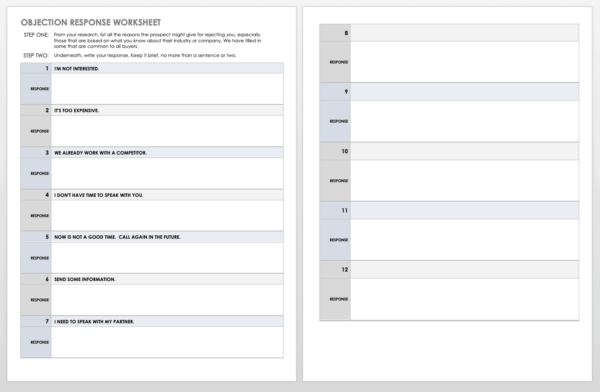
Business & Finance Articles on Business 2 Community
(38)
